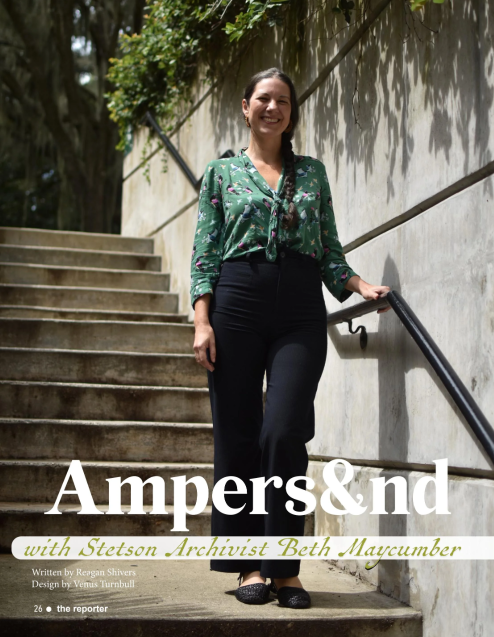Fernanda Castillo ‘26 is a first-generation college student-and former ballerina-from Guatemala, studying political science in the Stetson University Honors Program. Castillo transferred to Stetson from Daytona State where she founded the Ballet for the World Initiative, which aims to make fine arts, ballet, and creative writing accessible to children in the United States and Guatemala, regardless of their financial background.
Enriquez and her team provide free, weekly creative writing and ballet classes to students staying at Hope Place in Daytona Beach, an emergency shelter for displaced families. Enriquez also provides business consulting for Transformación Ballet, another youth dancing service in Guatemala.
Who do you serve?
“[At Hope Place], usually there’s around 60 families. I have from five kids to 20 kids per class, depending on how many children are at the shelter. Every single Friday I am at Hope Place, and I teach children how to dance [and write creatively]. We facilitate [ballet and creative writing] practice to these children because they wouldn’t have access to these classes any other way. Their parents cannot afford them, or their parents do not have a vehicle to take the children to extracurricular classes in the area.”
Where did your idea for the initiative come from?
“The idea came up at Daytona State College. We were required to meet 60 hours of community work, and I knew that I wanted to do something different; I knew that I did not want to go to [a] place and just volunteer for a few hours. I knew that I wanted to get involved in the community and give back to Volusia County, because I’m able to study at Stetson University because I have sponsors in Ormond Beach and I live with an American family. So, the community of Volusia County has been extremely supportive of me and my dreams and my goals as a student. I might not be able to give back to the extent that people are helping me, but I can help others with the knowledge I have.
I realized that ballet is a very elitist, very expensive art form, and it shouldn’t be like that. Anyone who likes dance, who likes to practice, should have access to it. And that’s when I realized, okay, this is something that needs to be addressed, because not a lot of people are doing something like this, either in the United States or in Guatemala.
I started the program, and the Rotary Club of Downton Ormond Beach heard about my idea… They [gave] $5,500 that we used to purchase all the materials that we needed to create our mini studio at Hope Place.”
Why ballet?
“The opportunities are very limited where I’m from, so where I grew up, we didn’t have a ballet school. I used to beg my mom to take me to ballet classes… But there was nothing in the area. Finally, when I was nine years old, a school opened, and it used to operate at a military barrack here in the area.
Ballet schools have bars, mirrors, [and] specific boards. We didn’t have that. We used to meet in a room with rustic boards that military men used to walk on before [it was a] historical building. We used to meet there three times a week and dance there. And that program helped me realize [that] I loved it. I love dancing, and [ballet] is what I want to do for the rest of my life.
My mom [brought] me along the way, and then I moved to Guatemala City to do further training. But then I realized, okay, there’s not enough opportunities in my country for me to continue developing. So, I moved to Florida. I trained there with a Russian teacher, and then I was able to get into a ballet in Chicago. However, COVID 19 started, and I was stuck in Chicago; I was not able to continue with this career and [pursue] my dream of becoming a ballet dancer, and I had to come back to Guatemala.
So, when I could no longer dance, I said, ‘Okay, I think it’s time for me to give back to the community.’”
How does your organization support your home country, Guatemala?
“In Guatemala, I operate in partnership with another non-governmental organization… Transformación Ballet. The director is from the United States. There are specific needs that Transformación Ballet has, such as understanding cultural backgrounds, because [the director is] American.
The idea is that in the future, whenever I finish my studies and I’m able to come back to my home country, Ballet for the World Initiative will work as a nationwide program, offering fine art classes for children in Guatemala.”
How many students has the Ballet for the World Initiative impacted?
“Last year, we facilitated approximately 130 plus classes in creative writing and ballet. We impacted more than 100 US children. Our team comprised [of] one Managing Director, one Creative Writing director, and seven volunteers. We partnered with a community organization, and we operated with a budget of $2,000.”
What’s next?
“Right now my main goal is to work on sustainability. I still have one year and a half left at Stetson, and after that, I’m not quite [sure] what I will be doing, I might be transferring to law school. I might be taking a gap year and coming back to Guatemala. And so it is really important for me that I find the people to support this program. I need to get this program out there.”
How can Stetson Students volunteer?
“I’m looking for other students who have knowledge in the fine arts. [Students that] take dance classes or any instrument or choir, and can commit to one day a week and teach one day a week for one hour. They can email me [at [email protected]].”




